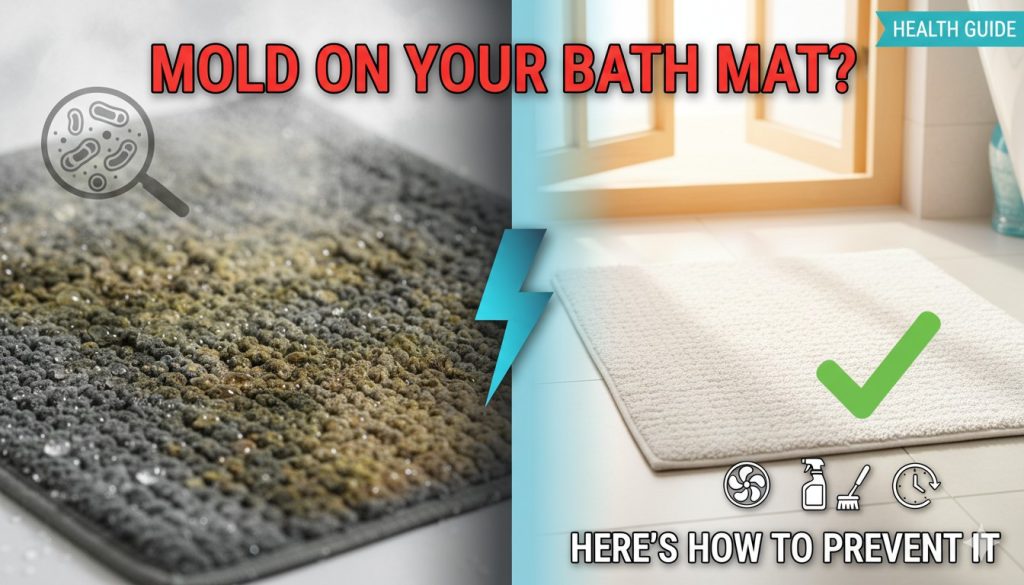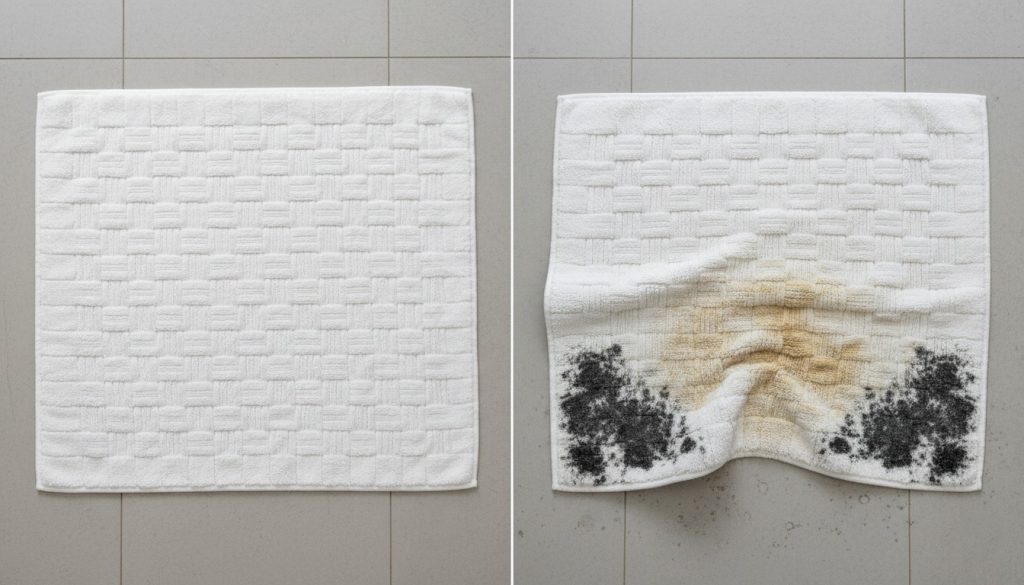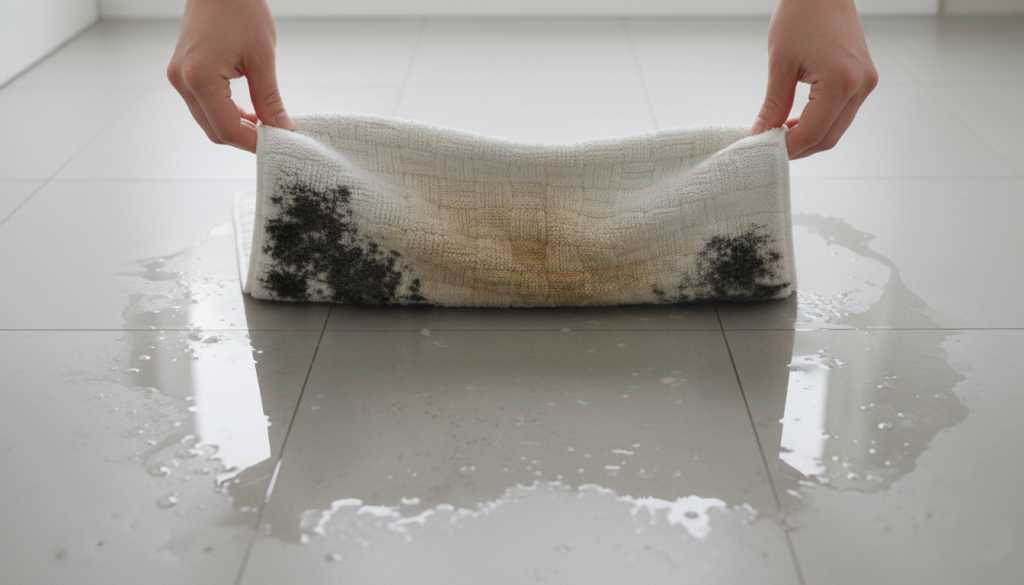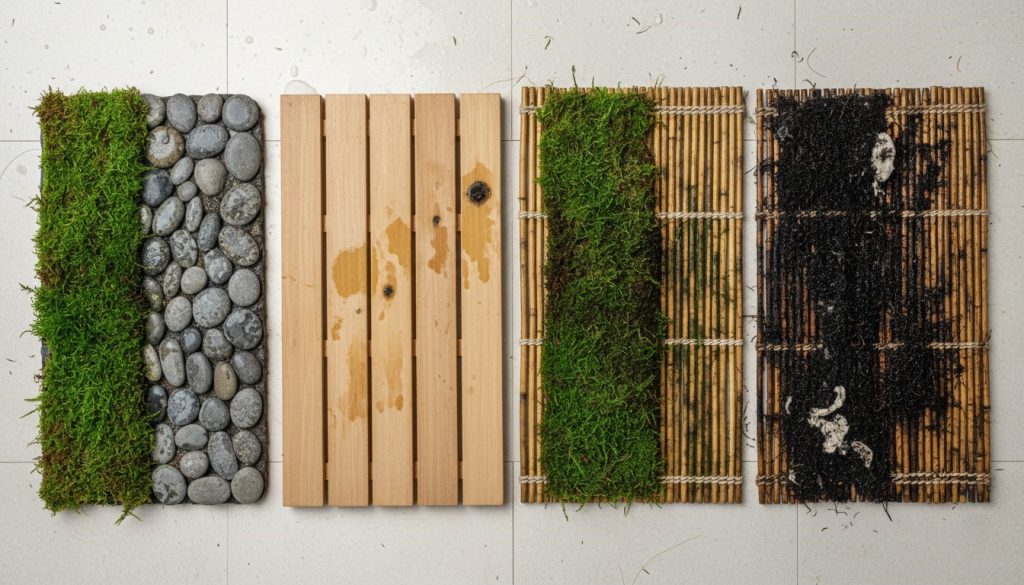
Introduction
I have to be honest—I didn’t think much about my bath mat until one morning I noticed a faint smell coming from the bathroom. You know that musty, slightly off odor that you can’t quite place? That’s when I realized I’d been standing on what was essentially a petri dish for the past few weeks without even noticing.
That experience led me down a rabbit hole of research about bathroom hygiene, and I discovered something pretty uncomfortable: most of us are doing bath mat care completely wrong. We buy them, use them daily, and barely think about what’s happening beneath the surface. Over the past few years, I’ve tested different mat types, experimented with prevention methods, and learned what actually keeps these everyday essentials safe and sanitary.
This guide shares everything I’ve discovered—the real issues, the practical solutions, and how to choose materials that actually work for your lifestyle and bathroom environment.
The Reality: Do Bath Mats Get Moldy? (Understanding the Problem)
Let me start with the question everyone’s probably wondering: Yes, bath mats absolutely get moldy. And it happens faster than you’d think.
Your bathroom is the perfect storm for mold growth. Every time you step out of the shower, your mat absorbs moisture. If that moisture doesn’t dry quickly enough, you’re creating an environment where mold and mildew don’t just survive—they thrive. The thing is, you might not even realize it’s happening. Mold can grow inside the mat while the surface looks perfectly fine.
From personal experience, I learned this the hard way. I had a plush cotton mat that I loved, but I kept it in a bathroom with minimal ventilation. Within two weeks, the bottom was discolored, and the smell was undeniable. I didn’t see it coming because everything looked okay from the top. That’s when I started understanding how sneaky mold really is.
The timeline is actually faster than most people expect. In a humid bathroom with poor air circulation, visible mold can appear in as little as one to two weeks. Even before you see it, bacterial colonies are already forming. The warm, damp conditions are basically an all-you-can-eat buffet for microbial growth.

Hygiene Concerns: Are Bath Mats Hygienic and Sanitary?
Here’s the uncomfortable truth: most bath mats are not as hygienic as we think they are, especially once they’ve been used regularly.
When I started reading about this, I learned that bath mats are basically designed to catch everything—water, skin cells, bacteria, fungi. That’s literally their job. But the problem is that all those things get trapped in the fibers, and unless you’re actively preventing mold and bacteria growth, you’re creating a breeding ground for microorganisms.
I talked to a few friends about their bathroom habits, and I wasn’t surprised to learn that most people wash their bath mats maybe once a month, if that. Some admitted they’d never actually washed theirs thoroughly. That’s genuinely concerning when you think about it, because you’re standing on that mat with wet feet—basically the ideal condition for bacteria to transfer from the mat to your skin.
The sanitary issue gets even more complicated in shared bathrooms. If you have kids, guests, or multiple people in your household, that mat is like a highway for germs and bacteria. Everyone’s bacteria, fungi, and whatever else they’re carrying is accumulating on the same surface. I realized I needed to either wash my mat much more frequently or find materials that are naturally more resistant to bacterial growth.
What really surprised me was learning that visible mold is actually just the tip of the iceberg. The bacteria and fungi growing on your mat are often invisible, which means you could be standing on a contaminated surface without any idea.
The Smell Factor: Understanding Bath Mat Odor Issues
Let’s talk about something everyone experiences but nobody really discusses: why do bath mats start to smell?
That smell isn’t just “wet textile.” It’s actually a red flag that bacterial and fungal colonies are thriving in your mat. I used to think a quick wash would fix it, but I learned that’s not always the case. The odor usually means the problem has already progressed pretty far.
I’ve had bath mats that smelled fine for the first week or two, then suddenly developed an unmistakable musty odor. That’s bacteria and mold releasing compounds as they grow. Some materials hold onto that smell worse than others—I found that dense, heavily padded mats seemed to trap odor more stubbornly than thinner ones.
The frustrating part is that even after washing, some mats still smelled off. That’s when I realized the smell had actually penetrated deep into the fibers, not just settled on the surface. For those mats, the smell was basically a signal that they’d reached the end of their useful life.
I started paying attention to when the smell first appeared, and I noticed it was a pretty reliable indicator that I should replace the mat or change my drying methods. Now I treat that first hint of odor as an early warning system rather than just something annoying.

Bacterial Growth and Safety: What You Need to Know
This is where things get genuinely serious. Understanding the health implications of bacteria on your bath mat changes how you approach bathroom hygiene.
When moisture sits in fabric, it creates conditions for bacteria like E. coli, Staphylococcus, and various fungi to multiply rapidly. If you have any small cuts or abrasions on your feet—which is easy to get from walking around—bacteria from the mat can enter your body. I know that sounds dramatic, but it’s the reality of how these surfaces work.
The risk varies depending on who’s using the mat. For healthy adults, the risk is relatively lower, but for kids, elderly family members, or anyone with a compromised immune system, contaminated bath mats become a genuine health concern. I started taking this seriously when my niece visited and I realized she’d be using a mat I hadn’t washed in weeks.
Beyond infections, bacterial overgrowth can trigger or worsen respiratory issues, especially in people with asthma or other respiratory conditions. The spores and compounds released by thriving microbial colonies can irritate airways, particularly when you’re in the warm, humid environment of a bathroom.
I learned that the number of bacteria on a bathroom mat that hasn’t been washed in a month can be staggering—we’re talking tens of thousands per square inch. That’s not a judgment on anyone; it’s just what happens when you create a warm, moist environment without intervention. The solution isn’t to panic—it’s to understand the problem and prevent it.
Material-Specific Vulnerabilities: Choosing Safe Options
Not all bath mats are created equal. The material you choose dramatically affects how quickly problems develop and how much maintenance you’ll actually need to do.
Stone Bath Mats
I was initially drawn to stone bath mats because they seemed like the cleanest option. They’re hard, easy to clean, and don’t absorb water the way textiles do, right? Well, sort of.
What I discovered is that stone—especially porous varieties like limestone or sandstone—still has plenty of tiny pits where water can hide. If those pits aren’t completely dry, mold will grow in them. I had a slate mat once that looked clean but had mold growing in the tiny cavities on the surface.
The real issue with stone mats, though, is safety. When they’re wet, they become incredibly slippery. I nearly took a fall getting out of the shower one morning because I’d rinsed the stone mat and stepped right onto a slick surface. That was a wake-up call about how physical design matters as much as material composition.
Stone mats also require consistent maintenance. You need to dry them thoroughly after each use and clean them regularly with appropriate products. Some stone can be damaged by harsh cleaners, so you have to be careful about what you use. And they’re heavy, which makes them less practical for people who like to move their mats around for drying or washing.
Wooden Bath Mats
Wooden mats seemed appealing to me until I learned about their vulnerability to water damage. Wood is hygroscopic, meaning it actively absorbs moisture. Even with a protective finish, water will eventually penetrate the wood, leading to rot and structural damage.
I tested a wooden mat in my master bathroom, and within a few months, I noticed the wood was starting to warp. The corners began curling up, and certain areas felt soft and compromised. That’s the wood rotting from the inside out. Mold was growing in the fibers of the wood itself, which you can’t really clean away—it’s baked into the material.
The safety concerns are real too. As the wood deteriorates, you get splinters, uneven surfaces, and potential for the mat to collapse or splinter unexpectedly when you step on it. I was especially concerned about this in a household with kids.
The maintenance required is substantial. You have to dry it completely after every single use, you can’t use regular machine washing, and you need to treat it with wood-protecting products regularly. For most people, that’s just not practical. I eventually replaced mine with something easier to maintain.
Bamboo Bath Mats
Bamboo felt like a promising middle ground—it’s more water-resistant than regular wood but still has that natural feel I liked. I was cautiously optimistic when I bought one.
What I found is that bamboo is definitely more durable than standard wood, but it’s not the miracle material I’d hoped for. Bamboo is still a natural material that absorbs moisture, and it’s actually quite susceptible to fungal growth. The smooth surface of bamboo can hide mold growth, so you might think it’s fine when it actually isn’t.
The positive aspect is that bamboo is easier to maintain than wood. You can rinse it, wipe it dry, and it holds up better over time. But it still requires intentional drying after each use, and it won’t last indefinitely if you’re not careful. I’ve had my bamboo mat for about two years now, and it’s still going strong, but I can see the beginning signs of wear and discoloration where moisture has been settling.
One thing to watch for with bamboo is that when it starts to deteriorate, splinters become a genuine concern. I caught a small splinter once, which reminded me that this is still a natural material with limitations.

Moss Bath Mats
The moss mat experience was genuinely unique. I was skeptical at first, but living moss mats are actually designed specifically to resist mold and bacterial growth because living moss actively fights off fungal pathogens. It sounds almost too good to be true.
Here’s the thing: moss mats work well, but they’re finicky. They need consistent humidity and can’t dry out completely, or the moss dies. That puts you in this weird middle ground where you need your bathroom humid enough to support the moss but not so humid that regular mold grows. It’s like playing Goldilocks with your bathroom humidity.
I had a moss mat for a while, and the real benefit was that it genuinely resisted getting gross. The moss stayed green and fresh-looking, and there was never that musty smell. But the maintenance was different from anything else I’d tried. You can’t wash it like a regular mat, you can’t dry it completely, and you need to replace it every year or so because eventually the moss just stops thriving.
The cost is also higher than traditional mats, and they’re not practical for every bathroom situation. If you have low humidity or inconsistent bathroom use, a moss mat will just die on you. But in the right environment, they’re kind of amazing from a sanitation perspective.
The sustainability angle appealed to me initially—moss is renewable, and the mats biodegrade. But then I realized I was replacing them annually, which meant I was generating more waste than with a traditional mat that lasts two to three years.
Prevention Strategies: How to Prevent Mold and Mildew
Understanding the problems is one thing; actually preventing them is another. This is where my real-world experience has been most valuable.
The most important thing I’ve learned is that prevention is 100 percent about drying. Mold needs moisture to thrive, so if you can keep your mat dry, you eliminate the biggest threat.
Immediately after stepping out of the shower, I now squeeze out excess water from my mat or hang it over the shower rod so water can drip off. That simple action cuts down on moisture retention dramatically. The mat still absorbs water initially, but it’s not sitting in a puddle, which is where problems start.
Air circulation is absolutely crucial. I invested in a small exhaust fan for my main bathroom, and the difference was noticeable. That constant air movement prevents moisture from accumulating in the fibers. On days when I can’t use the fan, I crack a window or leave the bathroom door open. Even passive ventilation helps.
I wash my mat much more frequently now—typically twice a month, sometimes more often if it seems to need it. I’ve learned that a regular wash cycle in warm water actually helps prevent mold buildup. I add a little white vinegar to the rinse cycle, which seems to help kill any developing fungal spores. Some people use baking soda for similar purposes.
Another thing that’s made a huge difference is rotating mats. I actually have two mats now, and I alternate them. While one is drying completely or being washed, the other is in use. This gives each mat ample time to dry thoroughly, which is hard to achieve if you’re using the same mat every single day.
The humidity level in your bathroom matters more than people realize. I use a simple humidity meter, and I try to keep my bathroom humidity under 60 percent. High humidity creates the perfect environment for mold growth. If your bathroom stays humid all day, you’re fighting an uphill battle with standard mats.
I’ve also started keeping a microfiber cloth specifically for wiping down my mat after I use it. That extra step of removing surface moisture before the mat has a chance to sit wet really does help. It takes maybe thirty seconds, but it’s genuinely preventative.

Material-Specific Care Recommendations
Once you understand the vulnerabilities, the care approach needs to be tailored to your specific mat type.
For cotton and microfiber mats, regular machine washing is your friend. I throw mine in with warm water and a gentle cycle, then dry it thoroughly. You can dry these mats in a dryer on low heat, which actually helps kill any developing pathogens. Never leave them damp—that’s inviting mold.
Stone and wooden mats need a different approach. You can’t machine wash these, so I rinse mine under running water, scrub gently with a soft brush and mild soap, then dry thoroughly with a towel. For wooden mats especially, I make sure they’re completely dry before storing them. I’ve also started treating my wooden mat with a food-grade mineral oil occasionally, which seems to help protect the wood and extend its life.
Bamboo mats fall somewhere in between. I can hand wash mine, sometimes in the sink with warm soapy water, then dry it immediately with a towel. I avoid submerging it for extended periods because that forces water deep into the fibers.
With moss mats, the instructions are usually to mist them with water rather than soak them, and to keep them in a humid environment. Regular washing as you would with textile mats would kill the moss, so you’re really just maintaining the moss itself rather than cleaning it in traditional ways.
The key with any mat is knowing what you can and can’t do. Pushing a material beyond its design parameters is how most of my failed mat experiences happened. I’d wash a wooden mat like it was cotton and wonder why it deteriorated so quickly.
I’ve also learned to pay attention to the manufacturer’s recommendations. They’re not just suggestions; they’re usually based on what actually works for that material. When I’ve followed those guidelines consistently, my mats have lasted longer and stayed cleaner.
Signs It’s Time to Replace Your Bath Mat
Even with perfect care, bath mats don’t last forever. Learning to recognize when it’s time to let one go has saved me from standing on genuinely unsanitary surfaces.
The first sign is usually persistent odor. If a mat smells even after washing, that’s a signal that bacterial or fungal growth has penetrated too deep for cleaning to fix. I’ve learned to trust my nose on this one.
Visual signs are also important. Discoloration, staining that won’t wash out, or any visible mold means the mat has crossed from “needs cleaning” to “needs replacing.” I’ve tried to salvage mats past this point, and it doesn’t work. The contamination is too established.
Feel is another indicator. If a mat feels slimy or excessively soft in places where it was previously firm, that’s usually the material beginning to break down due to moisture damage or mold infiltration. At that point, the structural integrity is compromised.
For natural materials like wood and bamboo, warping, soft spots, or splinters are clear replacement signals. These indicate the material is degrading, and you risk actual injury.
I’ve also started thinking about replacement in terms of time. I typically expect quality mats to last one to three years depending on the material and how well I maintain them. After that timeline, even if they look okay, I’ve often noticed they’re not performing as well as they did initially.
The cost-benefit consideration matters too. If you’re spending significant time and effort maintaining a mat to keep it sanitary, at some point it’s more practical to just replace it. My time has value, and constantly fighting with a failing mat isn’t worth the effort or the health risk.
Creating a Bathroom Environment That Minimizes Risk
Looking at this holistically, the mat is only one piece of the puzzle. Your entire bathroom environment affects how quickly problems develop.
Ventilation is genuinely the foundation of a healthy bathroom. Whether it’s a dedicated exhaust fan, a window you can crack open, or even just leaving the door open after showers, air movement prevents moisture from accumulating. I run my exhaust fan for at least thirty minutes after every shower, and it’s made a real difference.
I’ve also gotten serious about humidity monitoring. A simple humidity meter from any hardware store costs about ten dollars and gives you real data about what’s happening in your bathroom. Once I knew my humidity was running at 75 percent, I understood why I was constantly fighting mold. Now I manage it consciously.
Strategic mat placement matters too. I keep my mat outside the shower area, not right against the shower wall where water constantly splashes on it. I also make sure air can circulate underneath. Using a mat that has some ventilation built into the bottom, or placing a thin towel under it, helps with air flow.
I’ve started treating post-shower routine as a hygiene ritual. I wipe down the mat, open windows, turn on the fan, and leave the door open. Those few minutes of intentional drying make a huge difference compared to just closing the door and assuming the mat will dry on its own.
Addressing any existing moisture problems in your bathroom is also important. Leaks, condensation that never goes away, or water damage on walls—these are all signs your bathroom stays too wet. Fixing those underlying issues is honestly more important than finding the perfect mat.
Conclusion
Looking back at where I started—standing on a mat that had become a microbial hazard without me even realizing it—I can see how much my understanding of bathroom hygiene has evolved.
The main takeaway is that bath mats aren’t just a comfort item; they’re a hygiene concern that requires active management. Choosing the right material for your lifestyle, maintaining proper ventilation, washing regularly, and knowing when to replace your mat are the keys to keeping this everyday item safe and sanitary.
The good news is that none of this requires perfect conditions or excessive effort. It’s really about understanding what causes problems and taking small, consistent steps to prevent them. The drying, the airflow, the regular washing—these aren’t burdensome tasks when you realize they’re protecting your health.
I’m not perfect at this now. Some weeks I’m more diligent than others, and I still have occasional issues. But I’m genuinely more aware of what’s happening with my mat, and I take action before problems get serious.
Start wherever you are. Maybe you swap out your mat for one that’s easier to maintain. Maybe you improve your bathroom ventilation. Maybe you just start washing your mat more frequently. Whatever you choose, you’re moving in the right direction toward a cleaner, healthier bathroom.
Your bath mat is there to protect you after you shower. It deserves the same care and attention you’d give any surface you stand on daily. Once you start treating it that way, you’ll notice the difference in how it feels, smells, and—most importantly—how it functions as part of your daily hygiene routine.
Leave a Reply